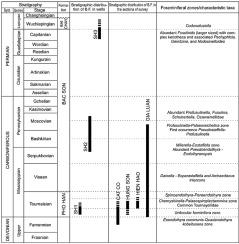当前位置:
X-MOL 学术
›
Mar. Petrol. Geol.
›
论文详情
Our official English website, www.x-mol.net, welcomes your
feedback! (Note: you will need to create a separate account there.)
Characteristic foraminifera of the Pre-Cenozoic carbonate formations of Cat Ba island and northern Song Hong Basin, Vietnam
Marine and Petroleum Geology ( IF 3.7 ) Pub Date : 2020-10-01 , DOI: 10.1016/j.marpetgeo.2020.104543 Mai Hoang Dam , Lieu Kim Phuong , Nguyen Van Sang Vo , Nguyen Thi Tham , Vu Van Huy
Marine and Petroleum Geology ( IF 3.7 ) Pub Date : 2020-10-01 , DOI: 10.1016/j.marpetgeo.2020.104543 Mai Hoang Dam , Lieu Kim Phuong , Nguyen Van Sang Vo , Nguyen Thi Tham , Vu Van Huy

|
Abstract Pre-Cenozoic carbonate formations of the northern Vietnam continental shelf have recently become important petroleum exploration targets, owing to the discovery of hydrocarbon accumulations in the northern Song Hong Basin. However, there is limited stratigraphic information about the carbonate basement in the area; further, the stratigraphic relationship between carbonate formations exposed in adjacent areas, such as outcrops on Cat Ba Island and the subsurface Song Hong Basin, is unclear. This study revealed foraminiferal assemblages that can be used to determine the age of carbonate basement rocks based on samples from outcrops on Cat Ba Island and wells in the northern Song Hong Basin. Foraminifera were identified and divided into eight biozones and one assemblage that are indicative of different ages. Carbonate formations on Cat Ba Island originated from the Famennian to Moscovian, and those in the northern Song Hong Basin originated from the early Tournaisian to early Wuchiapingian. Carbonates in the basement section of well SH1 and the Cat Co, Hung Son, Hien Hao, and Gia Luan sections of Cat Ba Island, originated in the early-mid Tournaisian. In well SH2, basement carbonates are coeval with the upper part of the Gia Luan section, indicating that it originated in the late Serpukhovian to the late Moscovian. This age range is significantly different from the Late Devonian to Early Carboniferous age determined by previous studies. The youngest basement carbonates were identified in well SH3 (early Capitanian to early Wuchiapingian). As these carbonate formations are contemporaneous, they were governed by the same tectonic conditions and may exhibit similar geological characteristics. Therefore, reservoir rock models of the carbonate basement in northern Song Hong Basin could be used to clarify geological carbonate models for Cat Ba Island.
中文翻译:

越南吉婆岛和松洪盆地北部前新生代碳酸盐岩地层特征有孔虫
摘要 越南北部陆架前新生代碳酸盐岩地层由于松红盆地北部油气藏的发现,成为近年来重要的油气勘探目标。然而,该地区碳酸盐岩基底的地层信息有限;此外,邻近地区出露的碳酸盐岩地层之间的地层关系,如吉婆岛和地下松红盆地的露头,尚不清楚。这项研究揭示了可用于确定碳酸盐基底岩年龄的有孔虫组合,这些组合基于来自吉婆岛和松红盆地北部井的露头样品。有孔虫被确定并分为八个生物区和一个组合,代表不同的年龄。卡巴岛碳酸盐岩地层起源于法门期至莫斯科期,宋洪盆地北部的碳酸盐岩地层起源于图尔奈世早期至五家坪期早期。SH1井基底段和吉婆岛Cat Co段、Hung Son段、Hien Hao段和Gia Luan段的碳酸盐岩起源于Tournaisian早中期。SH2井基底碳酸盐岩与嘉銮剖面上部同时期,表明其起源于谢尔普霍维晚期至莫斯科世晚期。这个年龄范围与先前研究确定的晚泥盆世至早石炭纪有显着差异。最年轻的基底碳酸盐在 SH3 井(卡皮坦阶早期至五家坪阶早期)中被识别。由于这些碳酸盐岩地层是同时期的,它们受相同的构造条件支配,可能表现出相似的地质特征。因此,松红盆地北部碳酸盐岩基底储集岩模型可用于阐明吉婆岛碳酸盐岩地质模型。
更新日期:2020-10-01
中文翻译:

越南吉婆岛和松洪盆地北部前新生代碳酸盐岩地层特征有孔虫
摘要 越南北部陆架前新生代碳酸盐岩地层由于松红盆地北部油气藏的发现,成为近年来重要的油气勘探目标。然而,该地区碳酸盐岩基底的地层信息有限;此外,邻近地区出露的碳酸盐岩地层之间的地层关系,如吉婆岛和地下松红盆地的露头,尚不清楚。这项研究揭示了可用于确定碳酸盐基底岩年龄的有孔虫组合,这些组合基于来自吉婆岛和松红盆地北部井的露头样品。有孔虫被确定并分为八个生物区和一个组合,代表不同的年龄。卡巴岛碳酸盐岩地层起源于法门期至莫斯科期,宋洪盆地北部的碳酸盐岩地层起源于图尔奈世早期至五家坪期早期。SH1井基底段和吉婆岛Cat Co段、Hung Son段、Hien Hao段和Gia Luan段的碳酸盐岩起源于Tournaisian早中期。SH2井基底碳酸盐岩与嘉銮剖面上部同时期,表明其起源于谢尔普霍维晚期至莫斯科世晚期。这个年龄范围与先前研究确定的晚泥盆世至早石炭纪有显着差异。最年轻的基底碳酸盐在 SH3 井(卡皮坦阶早期至五家坪阶早期)中被识别。由于这些碳酸盐岩地层是同时期的,它们受相同的构造条件支配,可能表现出相似的地质特征。因此,松红盆地北部碳酸盐岩基底储集岩模型可用于阐明吉婆岛碳酸盐岩地质模型。











































 京公网安备 11010802027423号
京公网安备 11010802027423号